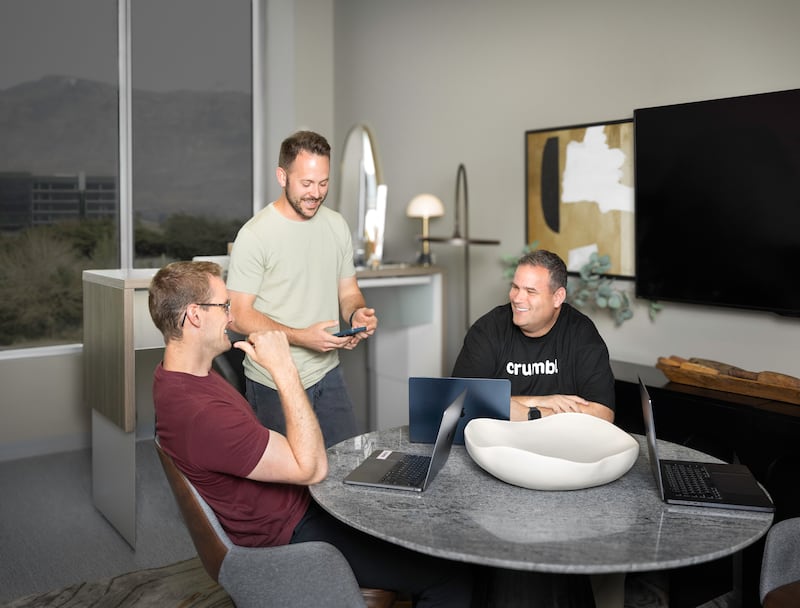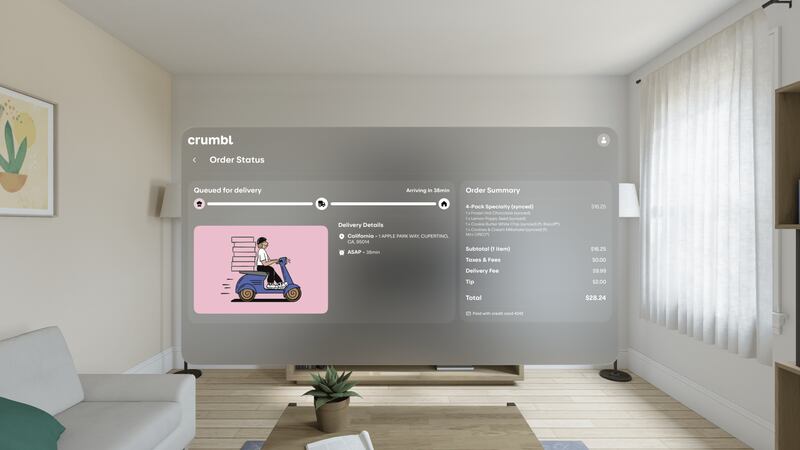This story appears in the June 2025 issue of Utah Business. Subscribe.
Crumbl, the eight-year-old retail gourmet cookie company, has more than 1,000 physical storefronts in the U.S. Recently, the brand opened a new shop you can’t touch or walk into, though you feel as if you can, courtesy of the Apple Vision Pro headset.
The year-old technology, starting at $3,499, isn’t for everyone — yet. But the beloved cookie company is banking on the idea that even niche technology has a way of affecting mass human behavior: throwing off new ideas, platforms and processes; inspiring engineers to create new products; and moving technology forward in unexpected ways.
Jacob Moncur, VP of engineering at Crumbl, says he once believed the Apple Vision Pro would replace the smartphone, but now he feels that it might one day supplant the laptop. “The benefits when you use one are clear,” he says, “and one day it will be ubiquitous.”
Butter, sugar, HTML
Moncur has worked at startups in Utah throughout his career: “I love technology startups. I’ve worked in a variety of different areas, from social media to TV to what looks on the outside like cookies, but if you dig into what Crumbl is, it’s a tech company.” Moncur and his team are tasked with building out the technology suite, the software that helps power and run Crumbl.
He says Crumbl was a tech company long before its foray into virtual reality. “Technology is in our DNA,” he says, recalling that he and Jason McGowan, Crumbl’s co-founder and CEO, have a shared history of launching startups that had nothing to do with baked goods. “That’s how we know each other,” he says. “i.TV was a big one. That was a company in Provo. We had some great initial funding and launching.” The two also worked together with Nintendo and with Comcast to build early TV applications during the heyday of iPhone mobile platforms.

McGowan launched Crumbl with Sawyer Hemsley in 2017, and Moncur formally joined three years later, though he’d stuck his hands into the cookie jar as a contractor in 2018 and 2019. From the beginning, Moncur says the team’s vision centered on technology empowering their delectable product.
“I helped build some of [Crumbl’s] earliest mobile apps that people used to order their cookies,” Moncur says. “Customers wanted to have cookies at their doorsteps. It’s the most magical experience when they show up at your house. To do this, we needed to build technology; that’s been a part of who we are since day one.”
Most fast-food restaurants offer a mobile ordering option and others facilitate takeout delivery with apps like DoorDash or Uber Eats. But to Crumbl, those innovations now seem quaint; the cookie company was the first to develop what came next.
A perfect flavor combo
Apple debuted the Apple Vision Pro — an augmented and virtual reality headset — in early 2024. Excitement coursed through the tech community.
Crumbl was equally thrilled by the announcement, but not surprised; they’d already been working with Apple to build a custom application for the new gadget. Before the VR product was available, Crumbl partnered with Apple to create an entirely new virtual shopping concept for the cookie brand.
“We’ve always had a really great relationship with Apple,” Moncur says. “We were trying to stay on top of technology and platforms, and Apple’s one of the best. Most of the people who order Crumbl go through our Apple iOS app, specifically.”
Crumbl, building on its tech-first legacy, was one of the first food and beverage companies with a virtual storefront and the only one headquartered in Utah. Moncur recalls how building the new storefront required his team to curate a completely unique experience for VR customers.
“It wasn’t just ‘Here’s your same phone app, but now it’s on the Vision Pro,’” he says. “We designed this whole experience around what it would be like in the Vision Pro. It’s a very visual experience — you can see your whole checkout flow, with amazing images of cookies right in front of your eyes.” To order baked goods, customers use their eyes as a cursor and their hands to select, grab and move items with no gloves or buttons required.
“Honestly, it’s not a No. 1 sales channel for us, but it speaks to the fact that we want to be at the forefront of any technological platform that we think could have legs in the future.”
— Jacob Moncur
To other companies interested in building applications for the Apple Vision Pro, Moncur would warn them that there are no shortcuts. You can’t copy and paste a virtual reality experience from a mobile platform, he says. His team of designers faced a steep learning curve when embarking on this tech frontier, but now that they’ve adapted, Crumbl’s technology is once again backed by industry-leading expertise.
Crumbl’s virtual storefront launched in concert with the introduction of Vision Pro “on day one — the only food and beverage app on there,” Moncur remembers. “It was fantastic to see people [ordering] live. We had made test orders ourselves, but when someone orders and they’re not just on your internal team, it’s exciting to see it out in the wild, making it happen.”
The sweet spot
Central to any technological product is the Japanese concept, popularized by Toyota, of “kaizen”: continuous improvement. “Kai” means “change” and “zen” means “for the better.” In the U.S., developers and creatives are apt to use the term “iterative process.”
Case in point: As Crumbl started witnessing the orders come through, they could see users were having a great time. “But there were minor things we needed to change to make it a better experience,” Moncur says.
Apple gave Crumbl valuable critiques based on what would work best on the platform. “It’s a new technology platform, and there are always challenges and figuring out the right way to do it,” Moncur says. “We probably went through 10 different design iterations, like ‘What does Crumbl look like in the Vision Pro? How should it be approached? What makes sense and what doesn’t?’”
The engineer provides an example of the iterative process involved in making the virtual storefront user-friendly: “If you open our app right now, or almost any of our social media platforms, every week we launch a video that shows all the cookies for the week.” Moncur describes Crumbl’s typical videos as almost frenetic, with quick scene cuts showing the cookie and tossing it. Moncur says they use the “very fast-paced videos because they’re exciting to see, and they get you hyped about the cookies.” But when you put that same video in the Vision Pro, right in front of your face, it can be “a very jarring experience,” he explains.

The unsuspecting viewer suddenly would be inundated by lights flying and flashing by. To solve that problem, the Crumbl team started creating different edits and cuts of the videos, versions that were less of a visual assault. “The new videos allowed you to see [the content] at a little slower pace,” he says. “Because it’s so amazingly huge and big and high-resolution right in front of you, your eyes just need a little bit more time to adjust and process that.”
But because Crumbl worked so closely with Apple on the experience, only small tweaks and changes were necessary. “It’s been able to keep up with the good design trends and good user experience and flow,” Moncur says.
Playing the long game
People have short memories, and they may not recall how expensive some new tech products were at launch. Back in 1997, the first flatscreen TVs cost between $17,500 and $20,000 (that’s around $34,000 today). The first digital cameras were priced at $1,000 in 1990. Fifteen years later, an entry-level model would only set you back around $100. Perhaps the Apple Vision Pro will follow suit.
Enjoying a Crumbl cookie might be about immediate gratification, but the company’s tech endeavor is about the long game. For one thing, the high-tech headset’s starting price currently targets a hyper-select audience. Out of the gate, sales were slow. But that hasn’t diminished Apple’s commitment to the product — the Apple Vision Pro 2 is reportedly in production. But there is no word that the new version will be less costly, and that’s the barrier to greater uptake.
“Setting some expectations here, Vision Pro is an expensive competing device,” Moncur concedes. “This is not a common household item that many people have. The market for it is not huge yet, but that’s not what it’s always about, right?” He says that Crumbl is committed to investing in the future of technology and understanding how the brand can be a part of that.
“Honestly, it’s not a No. 1 sales channel for us,” Moncur says, “but it speaks to the fact that we want to be at the forefront of any technological platform that we think could have legs in the future.” He says that Crumbl is primed to put more research and development into helping the virtual reality platform and its own product’s progress.
To achieve mainstream success, the glam gadget has to go in one direction. “It’s only a matter of time,” Moncur says. “It’s going to get smaller, it’s going to get cheaper” — he agrees that $999 might be the sweet spot — “and it’s going to get more powerful, just like we’ve seen with phones and personal computers.”

